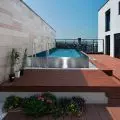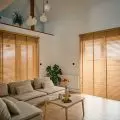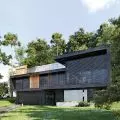The article is from A&B issue 9|23
I have been going about my creative process for many years unknowingly. Happily, I spent part of my professional time overseeing investment processes. Thanks to these observations, some time ago something set me off. What we call eco and bio when presenting visualizations of architectural structures is not at all what it seems. Green roofs and facades in a linear management system do not contribute to climate change prevention. They are not eco. They are only a soothing of our hidden remorse that we continue to concretize as much as we can.
fungus
In the series "The Last of Us," in which not viruses, not the atom and not even aliens from another planet fix our civilization, but an intelligent fungus does it, my attention was drawn to something other than the plot. It wasn't the main characters trying to somehow make ends meet in this unfriendly world, as the screenwriter would have it. My gaze wandered behind the foreground. I realized that the most interesting to my eye, and probably to my subconscious, were the cityscapes. The ones where civilization no longer exists. Buildings and streets, the entire volume was covered with vegetation. Unplanned, often pioneering, spontaneous, which mastered and gradually, without the help of architects and architects or architects and landscape architects, overgrows the cities. It creates a kind of symbiosis of buildings and infrastructure with vegetation. Interesting. All it takes is a smart fungus. Do you know that it really exists in our world? Ophiocordyceps unilateralis - that's the nice name for the fungus that turns ants into zombies. By the way, we also have its cousins in Poland.
Our hero, indirectly contributing to the "flowering" of serial cities, has done an interesting job at combining architecture with greenery. His real-life counterpart didn't get the idea to move from ants to humans. We'll wait and see. He left this greening to us and the mechanisms of nature.
Landscapes from the series. However, it is worth looking at them and maybe use them in designing the next "eco-neighborhood". For the time being, we are only creating "eco" for the patodevolutionary, which engulfs our country like the aforementioned mycelium, more spaces for "zombie-dwellers" who are insensitive to the aesthetics of space.
Meeting of Cultures Center in Lublin, overgrown parking lot
Photo: Wojciech Januszczyk
virus
Well, let's come down to earth. Some time ago, just like that, not from a fungus, but supposedly from a bat, a real story began. It allowed to observe as interesting phenomena as in the series. Leaving aside the great tragedy that has befallen our population, which has tapped 8 billion lives, it has become an important experience, from the point of view of architecture as well. Deserted streets, closed stores and stopped traffic around the world. The uncertainty of tomorrow. Amidst all this, the unbroken water in the canals of Venice, and the "dolphins" merrily frolicking and playing among the walls of the buildings. David Attenborough and his team showed many such examples from the animal world in a recent film. We saw how quickly other species populate our cities. Sometimes such species we wouldn't expect them to. However, the authors of the film focused only on animals.
From my observations, it seems that plants have taken over the human world just as interestingly. At the time, I was able to move around the city as an aid volunteer.
An overgrown wall and a self-growing green roof on a shed
Photo: Wojciech Januszczyk
I saw a number of pioneer plants begin an immediate expansion of any gaps in the pavement. These were not just plants from the vicinity of the so-called pre-steps, but really interesting species. Look at how quickly our garden space can become overgrown with so-called weeds and translate this to the city. All it takes is a few days, some rainfall, and the seed bank will take off. A gradual process of overgrowth will begin. More demanding plants will follow. They will blow away any concrete or asphalt quietly. It's not far from the first birch tree, and in a while the forest in the center of the city, which has so far developed beautifully like GDP, and our expansion by cars has led to the uprooting of everything that was green! There was no us, there was a forest! There will be no us, there will be a forest!
This, in my opinion, is one of the most interesting observations related to volumes and infrastructure.
This is really happening. Maybe a little hint for us, what to do in the era of climate change? How to use the mechanisms of nature in the design of buildings?
older peoples
There used to be civilizations that mastered and ripped out nature's space for buildings. It looks nice for tourists now. Buildings that were bustling with life, so overgrown. Everyone is taking salty pictures on Instagram as a tree wraps around a gate, a building or the head of a deity. It's getting a lot of likes. The Mayans, Aztecs and many other wonderfully developing civilizations, lived and passed away. Something didn't work for them. Some factor they didn't pay attention to. Maybe it was the equality of the worlds of the sacred and profane, of man and nature?
We have in the recent past our civilizations already covered with dust. Not so instagram-like anymore. PGRs. For younger readers - these are the large-scale, multifaceted State Farms that the "wind from the east" brought us with it. Today, in many, really many cases, the eastern, western and every other wind blows over farm and residential buildings once teeming with life. Overgrowth entered here, too, when that "civilization" died out or left for bread in a big-plate paradise. Space, like that of the Mayans or Aztecs, has been overtaken by a world of organisms that we look down on every day. So we also have our zombie mushrooms and lost civilizations locally.
equivocation
Perhaps using the above paragraphs, we can think about how to put the puzzle pieces together in this spatial and architectural puzzle and begin to truly connect the worlds, without preconceived dominance. A thought has been on my mind for some time: how to bring overgrowth, fourth nature and the not-so-good experiences of other civilizations into the halls of architecture? Especially since the clock of climate change is ticking, and I selfishly thinking about my genes, I would like my son to be able to pass them on in peace and live in as such well-being.
Words, sentences do an unimaginable job. Verbal communication. This is one of the most important things that caught my attention in these reflections. Let's go back in time a bit. As you may remember, the world of architecture and landscape architecture mastered the phrase equivalent of "For the disabled", which was changed by cases at all presentations of architectural objects. After a while, someone said: it can't be like that! An architectural object is supposed to be "accessible," that is, for everyone.
Immediately after that, all bio and eco went to the workshop, well, because the environment is endangered. In the circles of landscape architects such keywords are now "biodiversity" and "small retention". The words guide our design thinking. So drawing on this, I tried to start by contrasting the word "overgrowth" with the "concretion" created by Janek Mencwel. However, this is not enough. Equality. Something that gives the right to other organisms, such as we also have, to interact with the city and architectural creations.
The change regarding the way we perceive vegetation and communicate about it in relation to architecture is not just about designing and planting plants on green roofs, vertical gardens, balconies or the recently fashionable bus stops with a biologically active area on the roof. It is to design in such a way as to give the possibility for spontaneous vegetation to coexist with us in these objects. Giving it room to live independently. To coexist with us and our homes, so that it is a protocooperation, not a flower for the building's sheepskin. Creating their leaven, and then watching it grow. How it develops. How it changes our environment to be more friendly, while helping to prevent accelerated climate change. Not just adapting to the aesthetics of the building.
The Museum of the Przemysl Land in Przemysl overgrown with vines
Photo: Wojciech Januszczyk
The independent growth of plants on infrastructure and construction objects costs us nothing, we do not spend energy on them. Peat-free substrates, systemic water retention solutions are measures that promote this coexistence and this equality. The seed bank, wind and birds will do the rest for us. For this, however, it takes, first, courage, and second, a change in the approach to aesthetics. I call it "unsightly aesthetics".
green roof, green wall
On the path mentioned above, however, there is a problem. Greenwashing. many studios begin the presentation of their buildings with the sentence: "Our design is sustainable...". My blood pressure jumps. How are hundreds of tons of concrete, pipes, plastic, cables or glass and metal supposed to be what the designers are talking about? However, words are like stocks on the stock market, they often have no material backing. And then: "eco-friendly, because we have a green roof and a vertical garden." I don't listen further. A green roof is made on peat. Peat is the biggest accumulator ofCO2, and it's a greenhouse gas, says Prof. Marek Kotowski.CO2 does climate change. Plants for this roof are produced in a line management system on peat and delivered to the construction site in non-recycled pots. Then it's on to the irrigation system for watering. Water, of course, from the grid. Let's go further. Green walls. This is even more greenwashing of the facility. Here we have to deal with plastic, peat, an irrigation system that has to work practically non-stop. I don't see the balance here, nor the eco, bio. To make the building overgrown with plants, the usual hardy and great-looking Parthenocissus tricuspidata vines planted in native soil are enough. They do not need anything, they can manage on their own. For rooftops, peat-free soil and self-sustaining, pioneer plants that endure without watering. Simple, but not as nice as that one.
I have such a dream. Walk down a street that overgrows and combines wonderful architecture with the mechanisms of nature. Vines and vegetation on their own. However, in the case of climbing plants, you need to debunk the urban legend about bugs, moisture and so on. There is even a publication about it by Prof. Borowski. To sum up. There are many such greenwashing phenomena in our environment that we are not aware of. It is normal when there is no deeper reflection on the greenery - buildings relationship during the design process. However, in the era of climate change, we cannot afford such comfort. The dogma should be to take self-sustaining vegetation seriously, to give it back to facades and roofs and recognize that this is the right thing to do.
And here's a big request. No stitching, ladies and gentlemen designers. Because some people have weak hearts.
However, there is something in man
The war in Ukraine. I have a friend. A soldier, he is fighting the war so that we can have a nice democracy and live in peace. He had a choice, he could not go. Every day he gets up, goes to the minefields and takes care of taking his friends from those fields. Those who died, or those who, maimed for life, still lie there. The Russians set up hunts with sniper rifles on those like him, often leaving some wounded person for bait. Alexander worked with me for some time to create quaternary spaces, those of spontaneous vegetation. He once sent me a series of photos from the front. Within the walls of the destroyed building, where he and members of his unit rest during the rotation, he created a garden, a green space leaning against the walls of the building, entering it and interacting with the ruins. "It's for rest and to soothe the nerves," he wrote. He is not a landscape architect or an architect, but he probably knows more about the subject than some of us.
A War Garden created by a soldier at a rotation site just off the front line
Photo: Oleksandr Riuchyn
"Every capital city must have its Foster," circulates a malicious anecdote in our circles. This is probably how it will be after the war in Ukraine as well. Many studios are already beginning to divide the skin on the bear and are sharpening their teeth to "help" and rebuild. We will come to them there with the same greenwashing. We'll present eco-solutions that are eco-conscious. We'll do the same PR treatments and make many of the same mistakes as the architectural take all over, let's call it, the West.Too bad. But maybe we will understand in advance the mechanisms of nature, the real mechanisms. We will combine them with our creative process and let vegetation into buildings both with them and with us.
Wojciech Januszczyk
photo: Author



























